1Department of Zoology, Ghulam Nabi Azad Arts, Commerce & Science College, Barshitakli, Maharashtra, India.
2 Department of Zoology, Shri Shivaji Science College, Amravati, Maharashtra, India.
Corresponding author email: vairaleamit1@gmail.com
Article Publishing History
Received: 10/12/2020
Accepted After Revision: 25/03/2021
Spiders are among the most abundant insectivorous predators of terrestrial ecosystem and consume large number of preys without damaging the plants. Spiders, are the most common ubiquitous animals on land, constitute an essential portion of the predatory arthropods in several ecosystems. They play an important role in insect pest control without any harm to ecosystem. Spider species abundance in ecosystem can be high as undisturbed natural ecosystem, as they act as pest control creatures, which feed on destructive insects. The information on spider’s diversity is becoming increasingly important in the context of a global decline in the spider population. A survey of spiders was carried out in a tropical reserve forest of Pohra Malkhed, Amravati District during the years 2017-19. We have selected five microhabitats for observations in the study area viz; grassland, bush land, woodland, agricultural land and wetlands.
Spiders were collected by adapting standard sampling techniques and collected spiders were photographed and later preserved in 75% ethyl alcohol. Spiders were observed using stereo zoom microscope for study and identification of spiders was confirmed with the help of available keys. During the present study, we have reported 120 species of Spiders belonging to 14 Families and 37 genera, families such as Araneidae, Clubionidae, Eresidae, Gnaphosidae, Lycosidae, Oecobiidae, Oxyopidae, Pholcidae, Salticidae, Sparassidae, Tetragnathidae, Theridiidae, Thomisidae and Uloboridae were abundant. This study provides updated checklist and base-line data of spider fauna from Pohra-Malkhed Tropical Reserve forest of Maharashtra State India. Moreover, we expect this research to become a suitable milestone by providing credible information to the future analysis on the similar topics.
Diversity, Pohra-Malkhed, Tropical Reserve Forest, Spider.
Vairale A. B, Wagh G. A. Diversity of Spiders in Microhabitats of A Tropical Reserve Forest of Amravati, Maharashtra, India. Biosc.Biotech.Res.Comm. 2021;14(1).
Vairale A. B, Wagh G. A. Diversity of Spiders in Microhabitats of A Tropical Reserve Forest of Amravati, Maharashtra, India. Biosc.Biotech.Res.Comm. Biosc.Biotech.Res.Comm. 2021;14(1). Biosc.Biotech.Res.Comm. 2021;14(1). Available from: <a href=”https://bit.ly/3w6536o“>https://bit.ly/3w6536o</a>
Copyright © This is an Open Access Article distributed under the Terms of the Creative Commons Attribution License (CC-BY). https://creativecommons.org/licenses/by/4.0/, which permits unrestricted use distribution and reproduction in any medium, provided the original author and sources are credited.
INTRODUCTION
Spiders belong to order Araneae, class Arachinidae and are members of phylum Arthropoda, the largest assemblage of animal with jointed legs and hard exoskeleton. They are the largest group of arachnids comprising more than 44,000 species distributed over 110 families, worldwide as of the World Spider Catalog .They have unique habitat and they live in almost all the environments. They are the most abundant predator of insects of terrestrial ecosystem and consume large number of preys without damaging the plants.
Spiders are one of the dominant predatory groups found in ecosystems in India. They have special adaptations towards a predatory way of life. Their distensible abdomens enable them to consume large amounts of food in relatively short periods of time, while their rate of predation may greatly increase during short periods when plentiful supply of food is available (Sunderland and Samu, 2000; Jeyaparvathi et al., 2013, Platnik 2019, Rajeevan et al., 2019).
They have an exceeding high resistance to starvation, which enables them to survive and maintain normal reproduction during periods of low prey availability. Spiders, are the most common ubiquitous animals on land, constitute an essential portion of the predatory arthropods in several ecosystems. Spiders are known to occupying most of the terrestrial habitats. They are generalist predator, which can act against a broader range of insect pests (Sunderland and Samu, 2000).
Spider species abundance in ecosystem can be high as undisturbed natural ecosystem. Spiders act as pest control creature, which feeds on crop destructive insects. Spiders are beneficial bio-control agents of insect pest in the ecosystem and are known to occupy most of the terrestrial habitats. They are general predators, which can act against a broader range of insect pests (Sebastian et al., 2006, Jeyaparvathi et al., 2013, Wankhade and Manwar 2016).
Spiders are considered to be of economic value to farmers as they play valuable role in pest management by consuming large number of preys in the agriculture fields without any damage to crops. In spite of their importance as a generalist predator, the role of spiders in ecosystems is usually ignored, mainly because spiders do not fit into the conventional profile of biological control agents. Spiders are among the most abundant insectivorous predators of terrestrial ecosystem.
The current global list of spider fauna has approximately 44,057 of them, belonging to 3928 genera and 110 families. Spiders are an important but generally poorly studied group of arthropods that play a significant role in the regulation of insect pests and other invertebrate populations in most ecosystems, (Sebastian et al., 2006 Wankhade and Manwar, 2016 and Rajeevan et al., 2019).
Recently in agricultural fields reduced pesticide use and ecological sustainability have led to increased interest in spiders as potential biological pest control agents. Spiders act as natural biological control agent in ecosystem. Some recent workers on Indian spiders include (Majumdar and Tikader, 1991, Reddy and Patel, 1992, Biswas and Biswas, 1992, Sadana and Goel, 1995, Biswas et al., 1996, Gajbe, 1999, Biswas and Majumdar, 2000, Biswas and Biswas, 2003, and Bastawade, 2005, Rajeevan et al., 2019).
As per the literature cited very less work has been carried out in the tropical lying Pohra-Malkhed Reserve forest with respect to the spider diversity. Earlier 42 species of spiders were enlisted in and around Malkhed water body only of the Pohra-Malkhed Reserve Forest (Sebastian et al., 2006; Wankhade and Manwar, 2016). The study of Spiders was carried out in Pohra-Malkhed reserve forest of Amravati District during September 2017 – September 2019.
MATERIAL AND METHODS
The selected study area is of Pohra – Malkhed Reserve forest, which is the most diversity rich reserve forests of Amravati District. It is located between N 200 54’ 229’’ and E 770 51’ 104’’ with an elevation on 455 meter. Annual average rain fall is in between 1000 – 1600 mm. Total area under forest is 80 sq km. It is dry deciduous type and mixed type of forest with some grassland forest. More than 275 species of birds are reported form this forest. The other faunal species includes Mammals 17, Reptiles 26, Amphibians 04, Fishes 17, Butterflies 72, and numerous species of insects. This reserve forest has more than 150 plants species (Wadatkar et al., 2014).
The area receives rainfall during southwest monsoon. Average temperature of the district ranges from minimum of 10oC in winter to a maximum of 46oC in summer with the relative humidity varying from 10-15% to 60-95%. The spider inventory studies were conducted from September 2017 to September 2019 in the five different localities of Pohra-Malkhed reserve forest Amravati district from Maharashtra state. We have selected five microhabitats for observations in the study area viz; grassland, bush land, woodland, agricultural land and wetlands (Fig.1).
Figure 1: Map of Pohra-Malkhed Reserve Forest, District Amravati, Maharashtra (Study Area). Map of the study area was created by Shubham Wagh using Arch Map 10.5 & Arch GIS software.
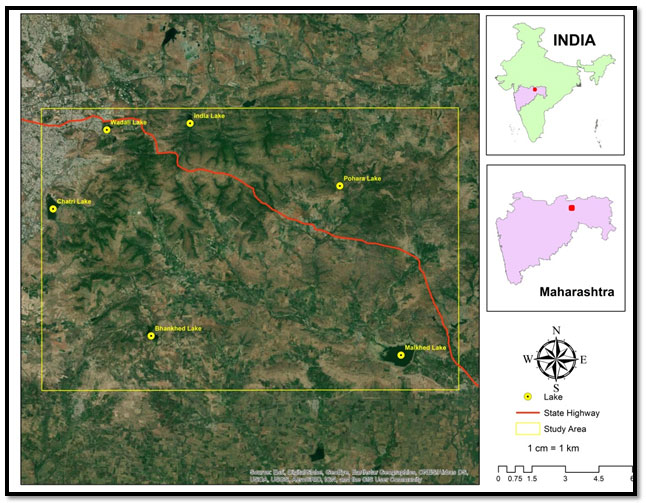
For the sampling method, Spider Inventory work was conducted at the ecosystems by different groups of workers. Four surveys were conducted per season at all study sites. Five 30 x 30 m quadrates were taken for extensive surveys. All surveys were conducted in the morning hours between 6:00am to 10:00am Spiders were collected by adopting standard sampling techniques as described below. 1. Sweep netting: Spiders from herbaceous-shrub-small tree vegetation were collected using standardized insect-collecting net.
This method is used to collect the foliage spider by this method from herbs and shrubs.2. Beating sheets: Spiders from trees and woody shrubs were dislodged and collected on a sheet by beating trees and shrubs with a standard stick. 10 beats per tree or shrub were employed in each quadrate. 3. Active searching and hand picking: Spiders from all three layers were collected using this method. In this method spider specimens were actively searched for 30 minutes per quadrat for searching under rocks, logs, ground debris, and loose dead barks of trees etc.4.
Litter Sampling: Litter i.e. deciduate from the ground was collected by hand and was put in big tray. Litter samplings involved sorting of spiders from litter collection tray. Collected spiders were photographed in life and later preserved in 75% ethyl alcohol. Identification: Spiders were observed using stereo zoom microscopes for studying identification keys. All specimens were initially separated from other material and identified to the family level. Spiders were identified upto species level using the standard monographs (Majumder and Tikader, 1991).
RESULTS AND DISCUSSION
During the study we had reported 120 species of Spiders belonging to 14 Families and 37 genera from the different habitats of the Pohra-Malkhed reserve forest. Spiders’ species were recorded from different 14 families viz Araneidae, Clubionidae, Eresidae, Gnaphosidae, Lycosidae, Oecobiidae, Oxyopidae, Pholcidae, Salticidae, Sparassidae, Tetragnathidae, Theridiidae, Thomisidae and Uloboridae. Abundance of the spiders species are arranged family wise with descending order. Orb Weaver (Araneidae) >Wolf Spider (Lycosidae) > Crab Spider (Thomisidae)> Jumping Spider (Salticidae) > Lynx Spider (Oxyopidae) (Fig.2, 3, 4&5).I
n this study two categories of spiders were observed, one was web weaver and another one was non web weaver. The web weaving spiders were belonging to the family Araneidae, Eresidae, Oecobiidae, Pholcidae, Tetragnathidae, Theridiidae, and Uloboridae. The non web weaving spiders were belonging to the family Clubionidae, Gnaphosidae, Lycosidae, Oxyopidae, Salticidae, Sparassidae and Thomisidae.
The increase in the spider’s density suggested that spider’s density was influenced by the increase in prey density. In particular area, the interaction of prey and predator showed a constant numerical interaction about these relationships which was fundamental to biological control. Spiders are considered as the favorable biological control agents in the forest ecosystem (Rajeevan et al., 2019).
Wetland spiders are in large number than after Shrubland and below grassland spider species. Due to grazing habitat the grassland spider species are comparatively lower than wetland and Shrubland. The spider species in debris are very much low and in wetland spiders species are more in numbers. In Western Ghats, Wayanad region, Kerala, India survey total 150 species belonging 73 genera under 20 families were recorded, where spiders of Family Salticidae (44) are dominant where as in our study of Pohra-malkhed reserve forest we were observed total 120Species belonging 37 genera under 14 families, where spiders of Family Araneidae (34) are dominant (Rajeevan et al., 2019).
Fig. 1: Checklist of Spider fauna from Pohra-Malkhed Reserve forest in Amravati district, Maharashtra State.
| Sr. No. | Family | Species | Common Name of Spiders | Habitat | Status |
| 1 | Araneidae(34) | Araneus cucurbitinus ♀ | Orb Weaver | Grassland | UN |
| 2 | Araneus mitifica (Simon) ♀ | Orb Weaver | Grassland | C | |
| 3 | Araneus mitifica (Simon)♂ | Orb Weaver | Grassland | C | |
| 4 | Araneus pachganiensis ♀ | Orb Weaver | Grassland | R | |
| 5 | Araneus pahalgaonensis ♀ | Orb Weaver | Grassland | UN | |
| 6 | Argiope aemula ♀ | Orb Weaver | Grassland | C | |
| 7 | Argiope aemula ♂ | Orb Weaver | Grassland | C | |
| 8 | Chorizopes anjanes ♂ | Orb Weaver | Shrubland | R | |
| 9 | Chorizopes calciope ♀ | Orb Weaver | Shrubland | C | |
| 10 | Cyclosa bifida (Doleschall)♀ | Orb Weaver | Shrubland | C | |
| 11 | Cyclosa bifida (Doleschall)♂ | Orb Weaver | Shrubland | C | |
| 12 | Cyclosa confraga (Thorell)♀ | Orb Weaver | Shrubland | C | |
| 13 | Cyclosa fissicauda Simon ♀ | Orb Weaver | Shrubland | R | |
| 14 | Cyclosa insulana (Costa) ♂ | Orb Weaver | Shrubland | UN | |
| 15 | Cyclosa moonduensis ♀ | Orb Weaver | Shrubland | C | |
| 16 | Cyclosa moonduensis ♂ | Orb Weaver | Shrubland | C | |
| 17 | Cyclosa mulmeinensis ♀ | Orb Weaver | Shrubland | UN | |
| 18 | Cyclosa neilensis Tikader ♀ | Orb Weaver | Shrubland | R | |
| 19 | Cyclosa simoni ♀ | Orb Weaver | Shrubland | C | |
| 20 | Cyrtophora bidenta ♀ | Orb Weaver | Shrubland | C | |
| 21 | Cyrtophora cicatrosa ♀ | Orb Weaver | Shrubland | C | |
| 22 | Cyrtophora citricola ♀ | Orb Weaver | Shrubland | C | |
| 23 | Larinia chloris (Audouin) ♀ | Orb Weaver | Shrubland | C | |
| 24 | Larinia chloris (Audouin) ♂ | Orb Weaver | Shrubland | C | |
| 25 | Neoscona achine (Simon) ♀ | Orb Weaver | Bushland | C | |
| 26 | Neoscona achine (Simon) ♂ | Orb Weaver | Bushland | C | |
| 27 | Neoscona bengalensis ♀ | Orb Weaver | Bushland | UN | |
| 28 | Neoscona bengalensis ♂ | Orb Weaver | Bushland | UN | |
| 29 | Neoscona nautica ♀ | Orb Weaver | Bushland | C | |
| 30 | Neoscona nautica ♂ | Orb Weaver | Bushland | C | |
| 31 | Neoscona theis ♀ | Orb Weaver | Bushland | C | |
| 32 | Neoscona theis ♂ | Orb Weaver | Bushland | C | |
| 33 | Zygiella indica Tikader ♀ | Orb Weaver | Bushland | C | |
| 34 | Zygeilla indica Tikader ♂ | Orb Weaver | Bushland | C | |
| 35 | Clubionidae(3) | Clubiona acanthochemis ♀ | Sac Spider | Shrubland | C |
| 36 | Clubiona analis Thorell ♀ | Sac Spider | Shrubland | C | |
| 37 | Clubiona analis Thorell ♂ | Sac Spider | Shrubland | C | |
| 38 | Eresidae(2)
|
Stegodyphus sarasinorum ♀ | Colonial Spider | On Trees | C |
| 39 | Stegodyphus sarasinorum ♂ | Colonial Spider | On Trees | C | |
| 40 | Gnaphosidae(8) | Drassodes lubrica Simon ♀ | Ground dwelling | Ground | R |
| 41 | Drassodes sagarensis ♀ | Ground dwelling | Ground | C | |
| 42 | Gnaphosa poonaensis ♀ | Ground dwelling | Ground | UN | |
| 43 | Gnaphosa poonaensis ♂ | Ground dwelling | Ground | UN | |
| 44 | Sosticus nainitalensis ♀ | Ground dwelling | Ground | R | |
| 45 | Sosticus poonaensis ♀ | Ground dwelling | Ground | C | |
| 46 | Zelotes poonaensis ♂ | Ground dwelling | Ground | C | |
| 47 | Zelotes sajali Tikader♀ | Ground dwelling | Ground | R | |
| 48 | Lycosidae(22) | Hippasa greenalliae ♀ | Wolf Spider | Wetland | C |
| 49 | Hippasagreenalliae ♂ | Wolf Spider | Wetland | C | |
| 50 | Hippasa partita ♀ | Wolf Spider | Wetland | C | |
| 51 | Hippasapartida ♂ | Wolf Spider | Wetland | C | |
| 52 | Hippasapisaurina♀ | Wolf Spider | Wetland | C | |
| 53 | Hippasapisaurina♂ | Wolf Spider | Wetland | C | |
| 54 | Lycosa barnesi Gravely ♀ | Wolf Spider | Wetland | C | |
| 55 | Lycosa bistriata Gravely ♀ | Wolf Spider | Wetland | C | |
| 56 | Lycosa choudhuryi ♀ | Wolf Spider | Wetland | R | |
| 57 | Lycosa fuscana Pocock ♀ | Wolf Spider | Wetland | C | |
| 58 | Lycosa poonaensis ♀ | Wolf Spider | Wetland | R | |
| 59 | Lycosa poonaensis ♂ | Wolf Spider | Wetland | R | |
| 60 | Lycosa prolifica Pocock ♀ | Wolf Spider | Wetland | C | |
| 61 | Pardosa annandalei ♂ | Wolf Spider | Wetland | C | |
| 62 | Pardosa annandalei ♂ | Wolf Spider | Wetland | C | |
| 63 | Pardosa birmanica ♀ | Wolf Spider | Wetland | C | |
| 64 | Pardosa birmanica ♂ | Wolf Spider | Wetland | C | |
| 65 | Pardosa timida (Simon) ♀ | Wolf Spider | Wetland | C | |
| 66 | Pardosa timida (Simon) ♂ | Wolf Spider | Wetland | C | |
| 67 | Pardosa minutus ♀ | Wolf Spider | Wetland | C | |
| 68 | Pardosa minutus ♂ | Wolf Spider | Wetland | C | |
| 69 | Pardosa timida (Simon) ♀ | Wolf Spider | Wetland | C | |
| 70 | Oecobiidae(2) | Oecobius marathaus ♀ | Tiny Spider | Bushland | C |
| 71 | Oecobius marathaus ♂ | Tiny Spider | Bushland | C | |
| 72 | Oxyopidae(9) | Oxyopes bharatae Gajbe ♀ | Lynx Spider | Grassland | R |
| 73 | Oxyopes biharensis ♀ | Lynx Spider | Grassland | UN | |
| 74 | Oxyopes burmenicus ♀ | Lynx Spider | Grassland | C | |
| 75 | Oxyopes chittrae ♀ | Lynx Spider | Grassland | C | |
| 76 | Oxyopes elongates ♀ | Lynx Spider | Grassland | C | |
| 77 | Oxyopes pankaji Gajbe ♀ | Lynx Spider | Grassland | C | |
| 78 | Oxyopes pankaji Gajbe ♂ | Lynx Spider | Grassland | C | |
| 79 | Peucetia viridana ♀ | Lynx Spider | Grassland | C | |
| 80 | Peucetia viridana ♂ | Lynx Spider | Grassland | C | |
| 81 | Pholcidae(2)
|
Artemaatlenta ♀ | Cellular Spider | On Wall | C |
| 82 | Pholcus phalangioides ♀ | Cellular Spider | On Wall | C | |
| 83 | Salticidae(11) | Marpissa decorata ♀ | Jumping | All habitats | C |
| 84 | Marpissa dhakuriensis ♀ | Jumping | All habitats | R | |
| 85 | Myrmarachne maratha ♀ | Jumping | All habitats | UN | |
| 86 | Myrmarachne maratha ♂ | Jumping | All habitats | UN | |
| 87 | Phidippus pateli Tikader ♀ | Jumping | All habitats | C | |
| 88 | Phidippuspaykulli ♀ | Jumping | All habitats | C | |
| 89 | Plexippus paykullii ♀ | Jumping | All habitats | C | |
| 90 | Plexippus paykullii ♂ | Jumping | All habitats | C | |
| 91 | Rhene indicus Tikader ♀ | Jumping | All habitats | C | |
| 92 | Telamonia dimidiata ♀ | Jumping | All habitats | C | |
| 93 | Telamonia dimidiata ♂ | Jumping | All habitats | C | |
| 94 | Sparassidae(2) | Heteropoda venatoria ♀ | Giant Crab | Debris | C |
| 95 | Heteropoda venatoria ♂ | Giant Crab | Debris | C | |
| 96 | Tetragnathidae
(4) |
Leucauge decorata♀ | Water orb weaver | Pond area | C |
| 97 | Leucauge fastigata ♀ | Water orb weaver | Pond area | C | |
| 98 | Tetragnatha mandibulata♀ | Water orb weaver | Pond area | C | |
| 99 | Tetragnatha mandibulata♂ | Water orb weaver | Pond area | C | |
| 100 | Theridiidae
(4) |
Argyrodes gouri ♀ | Cob web Spider | Pond area | R |
| 101 | Argyrodes gouri ♂ | Cob web Spider | Pond area | R | |
| 102 | Theridion manjithar ♀ | Cob web Spider | Pond area | UN | |
| 103 | Theridion manjithar ♂ | Cob web Spider | Pond area | UN | |
| 104 | Thomisidae(14) | Thomisuspugillis ♀ | Crab Spider | Garden | C |
| 105 | Thomisus pugillis ♂ | Crab Spider | Garden | C | |
| 106 | Thomisus whitakeri ♀ | Crab Spider | Garden | C | |
| 107 | Tmaruspachpediensis ♀ | Crab Spider | Garden | R | |
| 108 | Xysticus jayantius ♀ | Crab Spider | Garden | C | |
| 109 | Xysticus minutes ♀ | Crab Spider | Garden | C | |
| 110 | Xysticus minutes ♂ | Crab Spider | Garden | C | |
| 111 | Synaema decorata ♀ | Crab Spider | Garden | C | |
| 112 | Synaema decorata♂ | Crab Spider | Garden | C | |
| 113 | Thomisuselongates ♀ | Crab Spider | Garden | C | |
| 114 | Thomisus memae ♀ | Crab Spider | Garden | R | |
| 115 | Thomisus beautifularis♀ | Crab Spider | Garden | UN | |
| 116 | Thomisuspooneus ♂ | Crab Spider | Garden | C | |
| 117 | Thomisus projectus ♀ | Crab Spider | Garden | C | |
| 118 | Uloboridae(3) | Uloborus danolius ♀ | Feather leg Spider | On Wall | C |
| 119 | Uloborus danolius ♂ | Feather leg Spider | On Wall | C | |
| 120 | Uloborus khasiensis ♀ | Feather leg Spider | On Wall | R |
C=Common; UN=Uncommon; R=Rare; ♀=Female spider,♂=Male spider
Figure 2: Showing family wise spider species and their number
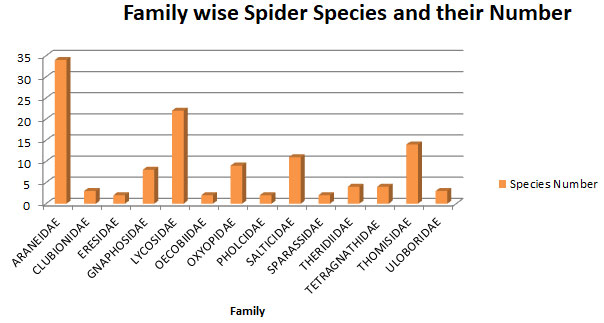
Figure 3: Showing common name wise spider –species with percentage
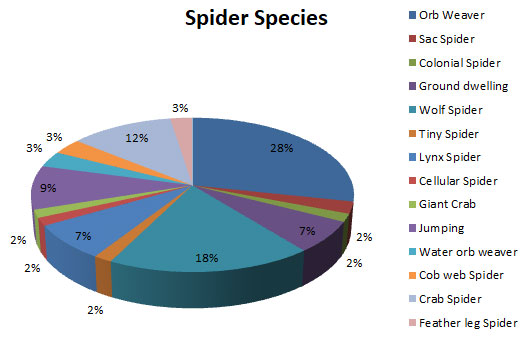
Figure 4: Showing habitat wise spider species and their number
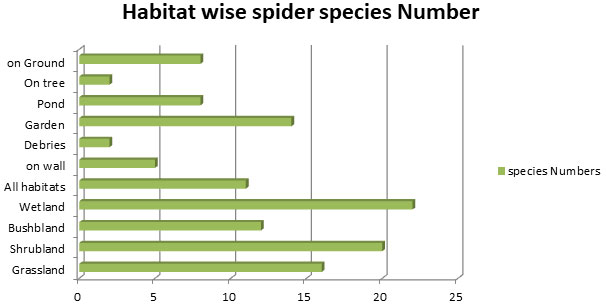
Figure 5: Showing encounter status of Spiders in the study Area
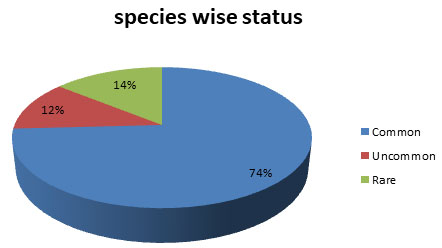
CONCLUSION
During investigation we have studied 120 species belonging to 37 genera of 14 spider Families. The present work includes the Taxonomic position and list of diversified species of spiders. The major families abundant in this forest are Araneidae 34, Lycosidae 22, Thomisidae 14, Salticidae 11, and Oxyopidae 09. The study shows information related to the species distribution in a particular habitat with response to the environment and availability of food. On the above result and discussion, it is clear that the Spiders are very much important creature and beneficial bio-control agent in the Forest ecosystem. Spiders are an integrated part of all ecosystems and contribute to the balanced ecosystem evidently due to their predatory potential. This study provides updated checklist and base-line data of spider diversity from Pohra-Malkhed Reserve forest in Amravati district of Maharashtra State. Study area shows great diversity of spiders.
ACKNOWLEDGEMENTS
The Authors sincerely acknowledge Amravati Forest Department authorities for providing all the needful information regarding the study area. We are very much thankful to t Mr. Shubham Wagh who designed and made available the study area Map.
Authors Contributions: Both the authors have equal contribution in bringing out this research work.
Conflict of Interests: There were no conflict among the interests of the participating authors.
Ethical Clearance Statement: The Current Research Work Was Ethically Approved by the Institutional Review Board (IRB) of Commerce & Science College, Barshitakli, Maharashtra, India.
REFERENCES
Ahmed, M. (2015). Diversity of spider fauna in agro-ecosystem of Sonipur district, Ph.D. thesis, Guwahati, University, India.
Bastawade, D. B. (2005). Arachnida: Araneae (Spiders), Zool. Surv. India, Fauna of Melghat Tiger Reserve, Conservation Area Series, 24: 421-435.
Biswas, B., and Biswas, K. (1992). Fauna of West Bengal (Araneae Spiders), State Fauna Series, 357-500.
Biswas, B., and Biswas, K. (2003). Fauna of Sikkim (Araneae: Spider), State fauna series, 9: 67-100.
Biswas, B., and Mujumdar, S. C. (2000). Fauna of Tripura (Arachnida: Araneae), State Fauna Series, 7:113-122.
Biswas, V., Kundu, B., Kundu, M., and Saha, S. (1996). Spiders of genus Oxyopus latreille (Araneae: Oxyopidae) of Buxa Tiger Reserve, West Bengal, Acta Arachnol, 45: 53-61.
Chetia, P., and Kalita, D. K. (2012). Diversity and distribution of spiders from Gibbon Wildlife Sanctuary, Assam, India, Indian Journal of Arachnology, 1(1): 130-142.
Gajbe, U. A. (1999) Studies on some spiders of the family Oxyopidae (Araneae: Arachnida) from India. Rec. Zool. Surv. India. 97 (3), 31-79.
Jeyaparvathi, S., Baskaran, S., and Bakavathiappan, G. (2013). Biological control potential
Meshram, A. (2011). Spiders (Arachnida: Aranea) from Toranmal Sanctuary, Maharashtra, India. E-International Scientific Research Journal, 3(4): 326-334.
Mujumder, S. C., and Tikader, B. K. (1991). Studies on some spiders of the family Clubionidae from India, Zoological Survey of India, New Alipur, Calcutta, 102, pp. 1-175.
Muzumdar, S. C., and Tikader, B. K. (1991). Studies of some spiders of Family Clubionidae from India. Rec. Zoo. Survey of India Occ. Pap., 102:1-173.
Pandit, R., Pai, and I. K. (2017). Spiders of Taleigao Plateau, Goa, India. Journal of Environmental Science and Public Health USA, 1(4): 240-252.
Platnik, N. I. (2019). The World Spider Catloge Version 17.5 American Museum of Natural History. Online at http// at research amnh.org//iz/ spider/catalog
Rajeevan, S., Smija, M. K., Thresiamma, V., and Prasadan, P. K. (2019). Spider Diversity (Arachnida: Araneae) in Different Ecosystems of the Western Ghats, Wayanad Region, India, South Asian Journal of Life Sciences, July-December Vol. 7, Issue 2, pp29-39.
Reddy, T. S., Patel. B. S. (1992). A new Species of Neoscona Simon (Araneae: Araneidae) from Coastal Andhra Pradesh India, Brief Communication. Entemon, 17 129-130.
Sadana, G. L., and Goel, N. L. (1995). New Species of spider of Genus Oxyopus latreille from India. Entomon, 20: 71-73.
Sebastian, P. A., Mathew, M. J., Sudhikumar, A. V., Sunish, E., and Murgeshan, S. (2006). Diversity of spiders of Mangalavanam, an ecosensitive mangrove forest in Cochin, Kerala, India. Zoological Survey of India, Series, 1:315-318.
Sunderland, K., and Samu, F. (2000). Effects of agricultural diversification on the abundance, distribution and pest control potential of spiders: A Review, Entomologia Experimentalist Applicata, 95(1), pp 1-13.
Wadatkar, J. S., Wagh, G.A., and Wath, M. (2014). Biodiversity of Pohara- Malkhed Reserve Forest, Amravati, FES & WECS Report.
Wankhade, V. W., and Manwar, N. (2016). Explorative study on the diversity and Characteristics of Spider Families, International Journal of Zoology and Research (IJZR), ISSN(E): 2278-8824, Vol. 6, Issue 1, 15-24.


